Current Research Interests
Chris Churchill
Assistant Professor of Astronomy
Overview
GOAL
I study the role of gas in the evolution of galaxies. My goal is to
obtain definitive observational data to constrain our models and
scenarios of galaxy evolution within the current paradigm of structure
growth in the cosmic web.
TOOLS
I use the spectra of quasars to study
absorption lines in the quasar spectra (a field called "quasar
absorption lines"). The facilities mostly used are the HIRES on the
Keck I telescope, the UVES on The Very Large Telescope, the STIS on
the Hubble Space Telescope, and the IRCS on the Subaru telescope.
Images of the quasar fields are also utilized in order to measure the
properties of the galaxies. the facilities mostly used are the WFPC
and ACS on Hubble and more recently SPIcam on the apache Point 3.5
meter telescope.
EXPERIMENTAL DESIGN
Quasars are very distant highly luminous objects. Their light travels
from the farthest reaches of the cosmos, throughout which gas and
galaxies are peppered in a giant cosmic web structure. On its path to
Earth, the quasar light probes the universe like a geological core
sample of space and time. With each interaction with a cloud of gas,
the dynamical motion of the gas and the chemical and ionization
condistions are recorded in the patterns in the light. By obtaining
the spectrum of the quasar, we can chart these patterns and study the
conditions of the gas.
Since the location of the pattern in the spectrum depends upon the
distance (or redshift) of the gas, and since the distance is also a
measure of the cosmic moment in which the cloud was probed, this
technique allows the gaseous properties to be charted over all cosmic
time. (Like a core sample, where the deeper layers are older layers).
Some of the gas arises very near galaxies. Figure 1 (above) is an
example of the imaging data I use to obtain the properties of the
galaxies.


Fig. 1 --- This is an HST image of the galaxy field around the quasar
3C 336, which is the bright object in the middle of the image labeled
"QSO: 0.927". The redshift of this quasar is z = 0.927. There are
many galaxies with lower redshifts, i.e., they are between us and the
quasar. Four galaxies and their redshifts are labeled. These galaxies
have a large exteneded halo of gas surrounding them and some of the
gas actually subtends in directly out in front of the quasar. The
properties of the gas can be studeid in the spectrum of the quasar and
the properties of the galaxies can be measured in the image and then
compared to the gas.
In the process, I compare the
detailed gas properties to the detailed galaxy properties. and
determine in their is any cause and effect processes between the two.
These absorption lines provide direct probes of the kinematic,
chemical, and ionization conditions in gas surrounding the galaxies.
In particular, I study the absorption lines from the strong, resonant
MgII 2796, 2803 doublet, which arises in the interstellar medium and
halos of galaxies. I am researching how large these halos are (how
far from the galaxies they extend), and their geometric shapes around
the galaxies.
Since my research is focused on the evolution of gas in galaxies with
the goal of obtaining observational data that are necessary for
placing constraints on models and scenarios of the role of gas in
galaxy formation and evolution, I also study the detailed properties
of the galaxies. These properties include their morphologies,
orientations, and their environments (do they belong to a group or are
they isolated in the field?).

Fig2. --- The light of the quasar (upper left) passes through the gas
in a galaxy (green). The gas comprises several gas clouds, each with
its own velocity (speed and direction, shown as blue arrows). The
gas absorbs the quasar light which is observed in the spectrum (lower
right). Each cloud absorbs light at different velocities.
In Figure 2 (above) a schematic of how the light is
absorbed by the gas clouds in an intervening galaxy and then recorded
in the spectrum is shown.
One important observational quantity is the "impact parameter", which
is the projected separation between the quasar and the galaxy in the
images. This is basically the distance out from the center of the
galaxy that the gas is being sampled by the quasar light beam. Figure
3, below, is a diagram showing the galaxy-absorption pairs as a
function of impact parameter.
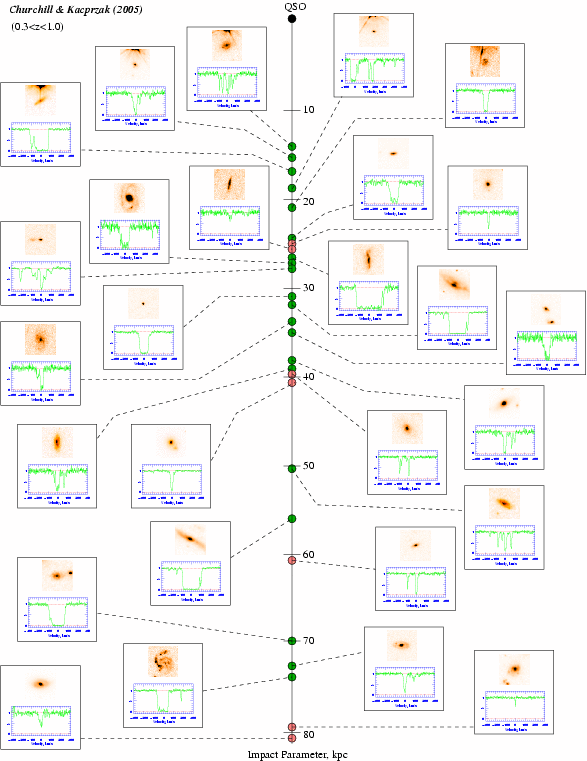
Fig 3. --- Each panel is a a galaxy-absorprion pair. The images of
the galaxies were obtained with the Hubble Space Telescope. The
spectra of the quasars were obtained with HIRES/Keck and UVES/VLT.
The transition of the absorption is the MgII 2796 trasition presented
in velocity spread. The line down the center provided the impact
parameter where the absorption arises (where the quasar sighline
samples the halo of gas surrounding the galaxy. (Note: in the images
at small impact parameter, the quasar acan be seen.)
Getting Detailed: Galaxy--Absorber Kinematic Connections
The focus of the project is to observationally quantify the kinematic
properties of galaxies that are selected by the presence of absorption
lines in quasar spectra. The absorption line arise in the extended
gaseous halos of the galaxies, which lie between us and the
quasars. These gaseous halos often extend to ten times the diameter of
the stellar component of the galaxies; how their dynamical properties
relate to the galaxies themselves remains unknown; it is our goal to
establish the specifics of these connections. This will involve
observations at the Keck, Gemini, and Apache Point Observatory (APO)
telescopes.
If so, it would imply galaxy halos are coupled to the galaxies both
dynamically and geometrically. If not, it would imply, perhaps, that
the halos come from the intergalactic medium and are accreted onto the
galaxies. The truth probably is a combination of both with varying
relative contributions on a galaxy by galaxy basis.
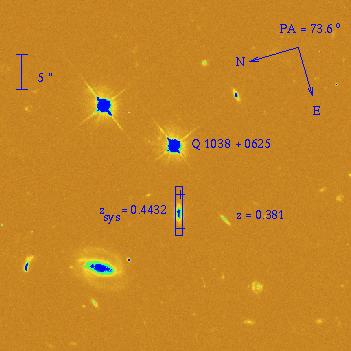
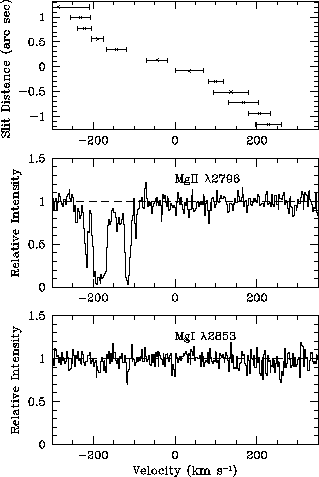
This is the figure caption.
This is a multi-year project (three years) and is now well established
as the Ph.D. thesis for Mr. Glenn Kacprzak, an NMSU astronomy graduate
student. Over the 2004-2005 academic period, we accumulated the
Hubble Space Telescope images and Keck/HIRES and VLT/UVES
quasar spectra for 38 galaxies in collaboration with Dr. Chuck
Steidel (Caltech), Dr. Michael Murphy (Cambridge). We will be
obtaining spectra of these 38 galaxies at the Apache Point Observatory
(APO), Keck, and Gemini telescopes in order to measure the kinematics
of the stellar components of the galaxies. These latter data are
critical for comparing the galaxy kinematics to the gas kinematics.
Going Deeper: The Weakest MgII Absorbers
By using the resonant transitions of MgII in absorption in the spectra
of quasars as a tracer of the presence of very low column density, low
ionization gas, one can explore the distribution of metals in the
gaseous medium that is the interface between galaxy halos and
intergalactic space. This is important for constraining scenarios of
metal production and transport in the early universe. In 1999-2000,
I charted the statistical properties of these gas clouds over the
redshift regime 0.4 < z < 1.4 (redshift corresponds to cosmic
time; z = 0.4 is about 5 billion years ago and z = 1.4 is about 9
billion years ago). Unexplored are the properties of the very weak
systems the high redshift regime 1.4 < z < 2.2 (a cosmic time span
reaching back to when the universe was 10% of its current age), where
active galactic halo formation is expected to be occurring.

This is the figure caption.
Graduate student Ms. Jessica Evans is analyzing the spectra and
finding new systems everyday. With roughly 400 spectra in hand, we
anticipate this will require more than a year of effort (1 quasar per
day!). Our goal is to then characterize the population of galaxies
associated with the population of weak MgII absorbers.
Going Further: The Highest Redshift MgII Absorbers
Absolutely nothing is known about statistical properties of {\MgII}
absorbers for z > 2.2 (actually we have a first result, but I'm not
telling yet!). With the recent advent of the sensitive infrared
spectrographs, it is now possible to extend our research (described
above) all the up to z = 4 (corresponding to when the universe was 5%
of its present age. For this very high redshift regime, I am
collaborating with Dr. Naoto Kobayashi (Tokyo). We are using the
infrared spectrograph (IRCS) on the Subaru telescope; Dr. Kobayashi
is the principle scientist of this instrument, which is currently the
only facility capable of this research.
We have slowly and methodically accumulated 36 infrared quasar spectra
since the Fall of 2003. We aim to obtain roughly 100 of these spectra
to complete the project. We will be publishing a paper on our first
results in the summer of 2006 or (the progress has been slowed by data
reduction snags experienced by Dr. Kobayashi).
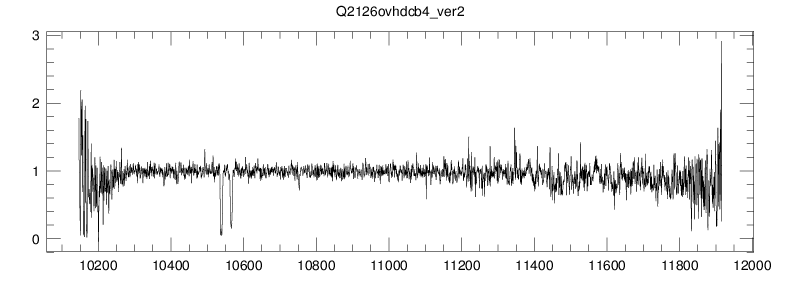
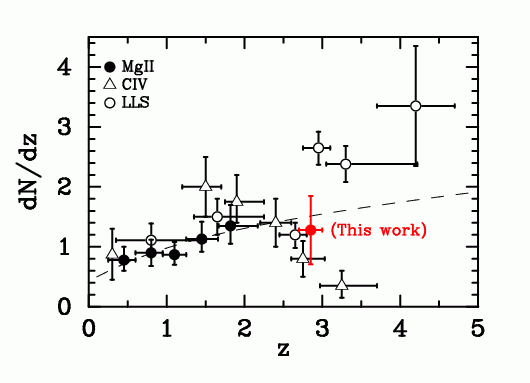
This is the figure caption.
The Cosmic Rise of Organic Molecules
In the interstellar medium of the Milky Way, organic molecules are
seen in abundance in gas clouds. They are observed in the spectra of
stars as so--called diffuse interstellar bands (DIBs). It is expected
that high redshift damped Ly-aalpha absorbers (DLAs) should also show
DIB absorption signatures. Thus, DLAs may provide an astrophysical
setting that will allow us to place constraints on the age of the
universe when organic molecules first appeared.
The goal is to chart the distribution of organic molecules as a
function of cosmic time and therefore determine the epoch at which
organic molecules first arise in the universe. Since these molecules
are the precursors for life on planets, we are aiming to constrain
when life could first arise in the universe. Our collaborators are
Drs. Ted Snow (Colorado, Boulder), Don York (Chicago), Sara Ellison
(Victoria, B.C.), and Naoto Kobayashi (NAOJ/Tokyo). In 2004, we
searched six DLAs for DIBs using the APO, Gemini, and VLT. We found
that presence of DIBs is far below expectations of those found in the
Milky Way. Since the abundance of organic matter is proportional to
the chemical enrichment of the gas, it is possible that lower
enrichment in DLAs is the culprit, not that the organic molecules are
missing altogether.
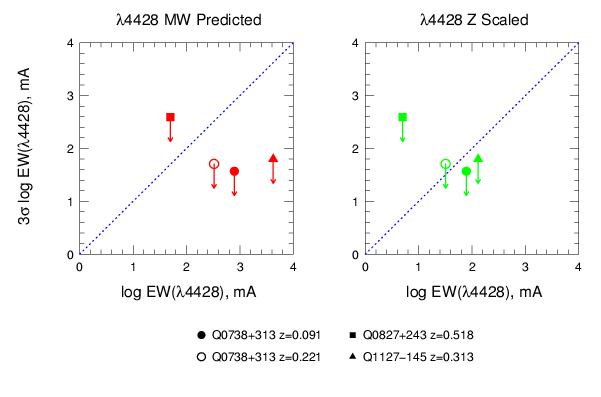
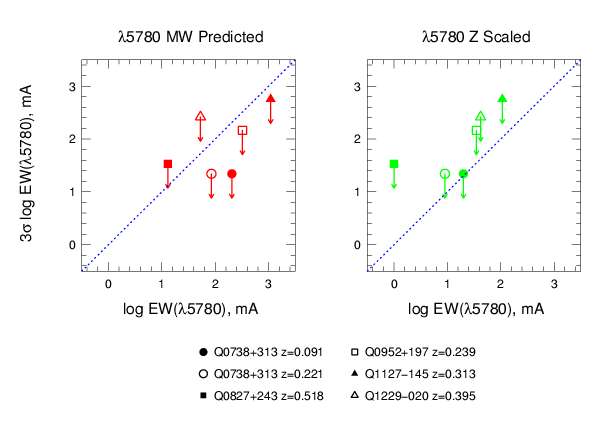
This is the figure caption.
We have a new angle that we are noe pursuing that incolves examining
the correlations between DIB absorption and PAH emission in
ultra-luminous infrared galaxies and starburst galaxies. We are
examining if there is evidence that certain DIBs are associated with
PAHs. Identifying the carriers of DIBs has been a long standing
problem of astrochemstry studies. This work is the Ph.D. thesis of
Mr. Brandon Lawton.
Text Book on the Subject
I am also engaged in the writing of graduate level text book on the
topic of Quasar Absorption Lines. I have completed 10 chapters,
mostly on review material and spectroscopic techniques. I estimate
that I am about half completed with this effort. The book is to be
delivered to Cambridge University Press by the summer of 2006 (I'd
better get to work!). the book will be part of the Astrophysics
Series published by the Press.
|










